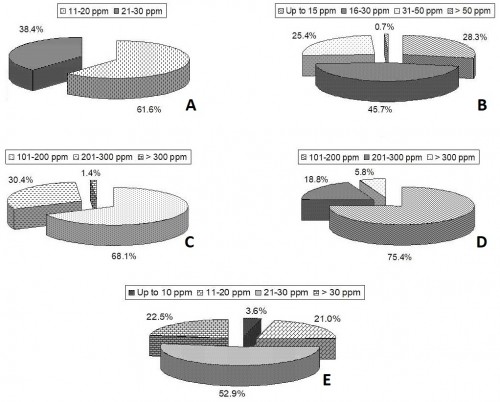Tropical Plant Research
An International Journal by Society for Tropical Plant Research
2018, VOLUME 5 ISSUE 1Pages: 96-106
Micronutrient status in leaf tissue of mango germplasm conserved under subtropical environment of Lucknow, Uttar Pradesh, India
Tarun Adak*, Kailash Kumar, S. K. Shukla, Vinod Kumar Singh and S. Rajan
*ICAR-Central Institute for Subtropical Horticulture, Lucknow-226101, Uttar Pradesh, India
Abstract:
On-farm conservation of elite and indigenous mango germplasm is crucial from the viewpoint of biodiversity conservation and its utilization for future use. Such conservation contributes to breeding of new varieties, research on biotic and abiotic stress complexes, evaluating nutrient dynamics in supporting their livelihood. One hundred thirty eight mango germplasms conserved in the experimental farm of CISH, Rehmankhera, Lucknow over decades were used for evaluating micronutrient status. The study revealed the lowest Zn content in Pan & Aswania (11 mg kg-1) to the highest in Rousa (28 mg kg-1) across these 138 mango germplasms while the corresponding values of Boron in Langra Digha (6.6 mg kg-1) and Husn-e-ara (44.8 mg kg-1). It was further inferred that a range of 6 mg kg-1 (Modami Model) to 52 mg kg-1 (Anaiwara) of Cu was estimated across these germplasms. In case of Mn and Fe micronutrients, wider variations across these germplasms were recorded. The concentrations of Mn varied between 122 (Mithua Bihar) and 347 (Prabha Shankar) mg kg-1 and Fe being 101(Shohrab Shah) and 461(Bombay Green) mg kg-1. The distribution pattern indicated that highest percentage of B (52.9%) was recorded in the range of 21–30 mg kg-1, 61.6% of Zn (11–20 mg kg-1), 45.7% of Cu (16–30 mg kg-1), 68.1% Mn (101–200 mg kg-1) followed by 75.4% Fe (101–200 mg kg-1). Wider variations in micronutrients contents in some existing commercial mango cultivars were found and such variations in micronutrient contents indicated the differential response of mango germplasms under similar soil-climatic conditions for future nutrient management strategy.
On-farm conservation of elite and indigenous mango germplasm is crucial from the viewpoint of biodiversity conservation and its utilization for future use. Such conservation contributes to breeding of new varieties, research on biotic and abiotic stress complexes, evaluating nutrient dynamics in supporting their livelihood. One hundred thirty eight mango germplasms conserved in the experimental farm of CISH, Rehmankhera, Lucknow over decades were used for evaluating micronutrient status. The study revealed the lowest Zn content in Pan & Aswania (11 mg kg-1) to the highest in Rousa (28 mg kg-1) across these 138 mango germplasms while the corresponding values of Boron in Langra Digha (6.6 mg kg-1) and Husn-e-ara (44.8 mg kg-1). It was further inferred that a range of 6 mg kg-1 (Modami Model) to 52 mg kg-1 (Anaiwara) of Cu was estimated across these germplasms. In case of Mn and Fe micronutrients, wider variations across these germplasms were recorded. The concentrations of Mn varied between 122 (Mithua Bihar) and 347 (Prabha Shankar) mg kg-1 and Fe being 101(Shohrab Shah) and 461(Bombay Green) mg kg-1. The distribution pattern indicated that highest percentage of B (52.9%) was recorded in the range of 21–30 mg kg-1, 61.6% of Zn (11–20 mg kg-1), 45.7% of Cu (16–30 mg kg-1), 68.1% Mn (101–200 mg kg-1) followed by 75.4% Fe (101–200 mg kg-1). Wider variations in micronutrients contents in some existing commercial mango cultivars were found and such variations in micronutrient contents indicated the differential response of mango germplasms under similar soil-climatic conditions for future nutrient management strategy.

Fig.: Distribution of micronutrients: A, Zinc; B, Copper; C, Manganese; D, Iron; E, Boron.
| 0 | 1 | 2 | 5 | 3 | 4 | 6 | 9 |


